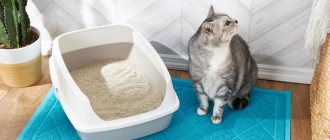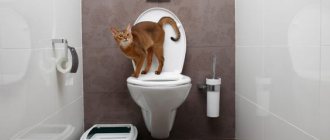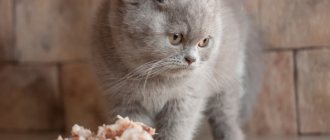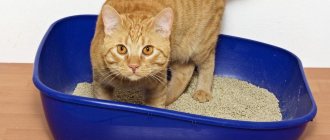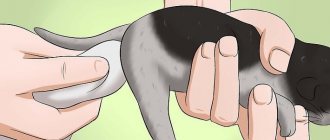If your purr continually spoils furniture, carpets, wallpaper, sharpening his claws, then it’s time to think about purchasing a scratching post (drapes, claw clippers). Anyone who owns a cat should have this convenient device in their home. This design ranks second in importance after the tray, because with its help the likelihood that your furniture will turn into a real disgrace is reduced to zero. But purchasing a scratching post is only half the battle. The hardest part is training your furry pet to adapt. We will tell you in detail about how to accustom a cat to a scratching post below.
Cat scratching post
Why do cats sharpen their claws?
Claw pointing is a natural process that occurs in every cat. Many owners believe that this action is nothing more than cat pampering or an attempt to harm. This opinion is fundamentally wrong. The habit of sharpening claws is equivalent to pulling up and playing with a ball. That is, it is necessary to maintain health and normal physical shape.
In addition, with the help of the point, the cat is freed from too long and exfoliated claws. If you do not allow the animal to carry out this action, then it will try to chew them off, which will lead to their fragility and delamination. This can cause inflammation of the nail bed.
Getting rid of bad and long claws and physical activity are not the only reasons. If we talk about the innate instincts that are inherent in every four-legged animal, then this process is needed to mark the territory. It is known that a special liquid is secreted through the pads on the paws - a secret that is felt only by animals. This action should demonstrate to everyone who is boss and show that the territory is already occupied.
While sharpening their claws, cats often damage furniture.
In addition, after waking up from sleep, cats need to warm up their muscles. To do this, they stretch out and cling tightly to the carpet or sofa with their claws.
Many veterinarians believe that this procedure is a great way for cats to relieve stress, expel all their anger and release excess energy.
Important! It is best to start learning in childhood. Kittens are very inquisitive and absorb new information like a sponge. It is much more difficult to train adult cats, who have long tested the strength of carpets and furniture upholstery.
Options for scratching posts and their types
Nowadays you can find many types of nail clippers in pet stores. They can be of different shapes, have different material composition, size and, accordingly, vary in price.
Main options for scratching posts:
- Columns. The most common and frequently purchased models. The pillars can be of different heights and widths. Therefore, this design can be easily adjusted to the height and weight of your pet. Pillar-shaped claws are wrapped in different materials. With the help of this device, a cat can not only sharpen its claws and get rid of old plates that interfere with the process of movement, but also strengthen the spine, joints, and stretch muscles. It is very useful. After all, most pets prefer a sedentary lifestyle and spend maximum time sleeping. Therefore, the load will not harm them. If we talk about order, then the drapery column is a very advantageous design. After all, it is much easier to collect fallen claws in one place than to look for them throughout the apartment.
Scratching post - column
- House. This drape performs two functions at once. The pet can sleep and exercise in it. The structure is covered on all sides with a special fabric. Therefore, there is no need to worry that the cat will ruin the structure. The pet can safely sharpen its claws in any area of the house.
Claw-claw - house
- Complex. Far from cheap, but at the same time a convenient option. Everything an animal needs for a full life is concentrated here - a place for sound and restful sleep, games, exercise and sharpening of claws. The device consists of numerous shelves, baskets, houses, columns, etc. The pet can spend here all day long, only occasionally leaving to relieve itself or eat.
Complex - scratching post
- Wall-mounted or vertical scratching post. Perfect for those purrs who like to spoil wall wallpaper with their claws. The models are presented in the form of wall boards. If your furry pet is used to picking off corners, then a corner scratching post is ideal for him. These are two boards that are attached to two walls.
Vertical corner scratching post
- Horizontal drape. Presented in the form of a small rug on which the cat can sharpen its claws. You can simply place it on the floor in a place where your pet likes to spend time. There are horizontal draperies with curves. This makes the process of sharpening claws more convenient. There are also volumetric structures, which are presented in the form of a pillar with a wide base.
Horizontal claw scraper
The claw boards are sheathed with various materials. The most accessible and quickly perishable is cardboard. It is most suitable for kittens. Adult cats can damage and tear it within a few weeks.
Cardboard drape
Another popular material is jute. It is more wear-resistant than the previous version. But the most important thing is that cats like jute more than all other materials. It is made from plants of the Malvaceae family, which are often used to create various weaving products, including ropes. A post made of jute can please your pet for several years.
Jute scratcher
The most wear-resistant and durable is sisal. Made from the leaves of the agave plant. The strands that wrap the scratching posts turn out to be rough and prickly. The structure is a bit like wood bark. This material lasts quite a long time.
Sisal nail clipper
Another material used for scratching posts is wood. It is carefully polished before sale. The material is durable. However, if made poorly, there is a possibility of injury to the paws or introduction of a splinter.
Wooden scratching post
Table 1. Comparative characteristics of the best scratching posts.
| Name | Short description. Dimensions, cm | pros | Minuses | price, rub. |
| Yami-Yami scratching post | Presented in the form of a flat round plate. Covered with jute material. 9.2×43.0 |
| Narrow. | 400 |
| Petmax Marine scratching post (wave) | The drape has a wave shape. The walls are lined with sisal. 50.0×18.0 |
| 1500 | |
| Basilio pillar with stable stand | Covered with jute thread. 36.0×52.0×36.0 |
| Weighs 4.5 kg. | 1500 |
| Lorca Trixie scratching post at an angle | Semicircular. Sheathing material is sisal. 37.0×27.0×75.0 |
| High price. | 4000 |
| Rugs with attached toy from Trixie | The surface is covered with sisal material. The color of the drape is your choice. 46.0×70.0 |
| 1500 | |
| Sheep with round shelf from Zolux | A column on top of which there is a sheep in the form of a round shelf in which the pet can hide or sleep. Made of wood. Covered with sisal material. 30.0×30.0×62.0 |
| High price. | 4500 |
| Claw-toy “Mousetrap” from Bradex | Made of high quality plastic. It is presented in the form of a platform, on top of which there is a claw sharpener made of carpet. 25.0×6.5×25.0 |
| 424 | |
| Cardboard scratching post “Fish bone” by Karlie Flamingo | Made in the shape of a fish bone from corrugated cardboard material. 11.0x12.0x48.0 | There is a carrying handle. | Short-lived. | 800 |
| Claw sharpener-house “Mouse” from CLP | Made in the form of a house. There is a sisal drape on the top. 33.5×51.0×27.5 |
|
| 1700 |
Why do cats tear up furniture?
Cats tear up furniture and wallpaper not out of spite. There are understandable physiological and psychological reasons for this behavior:
- In the vast majority of cases, pets sharpen their claws for hygienic purposes, because the keratinized top layer needs to be removed from them periodically. Just like the skin, dead cells peel off from the claws over time. If they are not removed, the horny plates become deformed and the cat will not be able to freely pull them into the paw pads.
- Although domesticated, the cat remains an animal that needs to mark its territory. On the pads of its paws there are special sweat glands, with the help of which the pet leaves a smell characteristic only of it. The owner's favorite chair can be especially attacked. This way the cat shows favor and love.
- Stretching and scratching is excellent exercise for apartment cats that do not have the opportunity to roam freely. By doing such exercises, the animal stretches its muscles and tendons.
- Some excitable and restless animals scratch furniture when they are nervous. They need to relieve tension. This often happens if another pet appears in the house.
- Claw release is an ancient cat instinct and must be trained periodically.
Cats tear up furniture, carpets and wallpaper not out of harm, but for physiological reasons.
From personal experience. Our cat behaved decently until about two years old, did not encroach on the sofa, armchairs, etc. But it so happened that the children grew up and he often began to stay at home alone, left to his own devices. He began to tear everything he could. And at first only alone, and later he began to do it demonstratively.
Claws need to be sharpened periodically to remove the keratinized layer.
It is impossible to convince nature itself and simply force the cat not to do what you don’t like. A smart owner will provide the animal with an alternative without compromising its natural needs.
It is believed that the cause of a pet's bad behavior may be poor upbringing. If you don’t teach your pet to do it right, then he simply won’t know how to behave.
What is a scratching post
Under no circumstances should you deprive your cat of the opportunity to sharpen its claws, as this can have a detrimental effect on its well-being and health. It is necessary to provide her with a special place to satisfy this natural need. For this purpose, there are specialized devices - scratching posts or claw boards. They come in different designs and are made from various materials (wood, sisal, carpet, etc.).
The simplest and most inexpensive model is the column
Let's look at the main types of devices for sharpening claws:
- Scratching post-post. The simplest design, which is a vertical column mounted on a stable base.
- Stationary or wall-mounted scratching post. A flat piece, mounted on the wall and does not take up much space.
- Scratching post house. An object that combines a place to hide and a surface to scratch.
- Scratching post-bed. A horizontal structure on which the cat can lie and sharpen its claws.
- Scratching post toy. During play, the animal may scratch the surface provided for these purposes.
- Scratching post complex. The best solution. Consists of beds (resting places), toys, several claw pads and other things.
Some cats prefer vertical scratching posts
To order, you can make completely unusual scratching posts, which are exclusive products and fit perfectly into the surrounding interior.
You can relax on the bed and sharpen your claws
From personal experience. When I was little, we had a Siamese cat. She loved to sharpen her claws on the leg of the kitchen table. All attempts to wean her did not lead to a positive result. The harmful animal was just beginning to cause even more mischief. The solution turned out to be extremely simple. The table leg was simply covered on all sides with thin wooden plates and the cat was given freedom of action. All her life she scratched only here and did not spoil anything else. The boards were replaced with new ones as they wore out.
The ideal option is a gaming complex
How to choose and where to place a scratching post
If the pet is already an adult, then the first thing you need to pay attention to is the place where he likes to engage in claw points. If it is a carpet, then it is better to give preference to horizontal models. If these are walls, doors, corners, then vertical. The right choice will allow the cat to quickly understand what you want from it, and the training will go much faster.
If you plan to buy a vertical scratching post, then it must be stable. It should not swing from side to side, topple or fall under the pressure of the animal. Such a model will not bring any benefit, and the cat is unlikely to come close to it anymore.
The height of the cat must also be taken into account. The height of the drape should be slightly larger than the size of the pet. It is ideal if the animal's claws do not reach the top of the structure for the point of the claws.
Choosing the right location for a scratching post is the key to success
The device should be installed where the cat does it most often. If it's a door, stick it there; if it's a carpet, lay it on the surface. Of course, it is not always convenient when the scratching post is under your feet or in the aisle. But this is only temporary, until the cat understands the purpose of this useful thing. When this happens, you can gradually move it away and, in the end, place it where it is convenient for you.
Important! It makes sense to place the nail clipper where the cat sleeps most often. After all, after waking up, cats love to stretch out and sharpen their claws.
The best location for the scratching post is where the cat sleeps most often.
Types of scratching posts
Before you go to the nearest pet store for a scratching post, watch your pet for a couple of days. What does he like? Climbing up a door frame? Scratch your claws on the living room carpet? Jump after flying butterflies? Or maybe, when he wakes up in the morning, he likes to crawl on his back under the chair and enjoy tearing at its bottom? Depending on the preferences of the little prankster, you will have to choose a simulator for him.
Modern scratching posts consist of a wooden base wrapped in twisted sisal fiber rope or covered with sisal fabric.
The following types of scratching posts can be found on sale:
- Stationary - they can be straight or angular, they are fixedly attached to the wall, they can be fixed not only vertically, but also horizontally;
- Floor mats can be flat or voluminous, the former are sisal rugs of various shapes and sizes that are pleasant to scratch with claws, and the latter look like cylindrical posts of different heights on a wide base, which are tightly wrapped with sisal rope. Often they have balls or pompoms attached to them that the kitten will enjoy catching. When choosing such a scratching post, pay attention to how tall it is. It is advisable to immediately buy a trainer for growth.
In addition to ordinary scratching posts, there are many real complexes in which posts, platforms and houses wrapped in sisal form a complex structure where your pet can not only play, but also take a sweet nap. They cost much more than usual, but are very comfortable and give kittens a lot of fun.
How to train an adult cat to use a scratching post
Many owners make the irreparable mistake of screaming and hurting their pet after the next claw point on the sofa or carpet. Of course, this is terribly annoying. However, as mentioned earlier, this is their natural instinct, so the animal will not understand why the owner’s anger is justified. It is better to shout out his name or strictly say “no!” while sharpening his claws on the furniture. Gradually, your pet will begin to understand what is causing your indignation.
Some cats are very vindictive. Therefore, if you constantly beat them or scream, then they are capable of committing meanness - relieving themselves in their slippers, favorite shoes, or in the bed.
Important! If your pet constantly sharpens its claws on the carpet or furniture, spray it with water from a spray bottle. Contact with any liquid is unpleasant for cats. Therefore, after some time, he will associate the process of touching the sofa with a nuisance that must be avoided by all possible means.
Kitten's reaction to punishment
In addition, this is an excellent opportunity to show him a new design - a scratching post - and show him how to use it correctly. Just place your pet's paws on the surface of the drape and imitate the dot process. When your cat releases his claws, praise him, pat him on the head, or give him his favorite treat.
The cat gets acquainted with a new scratching post
Attention! Cats love it when their owners praise them. Moreover, the gingerbread method is much more effective than the stick method.
If your furry pet completely refuses to sharpen its claws on the design that you showed it, and persistently continues to spoil the furniture covering and walls, try putting a couple of sprigs of catnip (catnip) on the nail sharpener. The herb is sold at any veterinary pharmacy or pet store. This will attract the cat, and she will definitely pay attention to the new design and, perhaps, figure out how to use it on her own - without additional actions on your part.
In order to discourage your cat from places where she likes to sharpen her claws, spray them with water diluted with orange, lemon, and grapefruit esters (2 drops per half glass of water is enough). This will definitely keep your pet away from his favorite furniture, carpets and wallpaper.
Important! Some owners practice this method. They stroke their pet with a handkerchief with the scent of someone else's cat. Naturally, the pet will not withstand such impudence and will want to get rid of the enemy who has encroached on its own territory. Hang the scarf on the scratching post. Then the cat will definitely want to vent all his anger on her, trying to rip off the hated scarf from her.
This method will also be useful. It is used if all others are useless. Cover all the cat's favorite places with plastic, and reward him with his favorite treat for each use of the scratching post. Cats really don’t like polyethylene because it’s impossible to grab onto it with their claws. Of course, this method is not always convenient, but it is very effective.
Scratching post - wave
For the same purposes, it is advisable to use double-sided tape. The paws will constantly stick, and cats really don’t like that. Surely, one attempt will be enough to repel your pet from the surface of the furniture. Then he will look for another convenient place. Now is the time to show him the scratching post.
Attention! You can use cinnamon, black pepper, regular powder, or curry spice as repellents. If an animal touches the surface with its paws, dust will rise and clog the fidget’s nose. This will scare the animal away forever.
What to do first and what to do next?
- Place the nail clipper in the desired location.
- You shouldn’t immediately “hook” your cat onto a sharpener, because new objects sometimes cause fear in animals. A persistent acquaintance can scare your pet away from the structure forever. So wait a while. Let the cat first come up to it, smell it, and examine it. This may take several days. Be patient.
- When familiarization occurs, try to show the animal how to use this item.
Scratching post on the wall
- Don’t insist, let your pet understand how nice it is to sharpen his claws on a cloth.
- If this does not happen, and the cat stubbornly continues to try to ruin your furniture, then every time it tries to do this, take the cat to the scratching post and run its paws along the surface.
- Try to repeat these steps several times a day.
Believe me, your efforts will definitely pay off soon.
Should I use mint or valerian?
Valerian (aka cat root) or mint do not harm cats, but they attract them with their smell, causing excitement. However, frequent use of these drugs is not recommended, as they have an intoxicating effect. The plants contain essential oils that resemble the smell of sex hormones, so males react more violently and faster to valerian. But even if pets eat a small amount of plants, there will be no harm from it. On the contrary, mint has a calming effect. To accustom your cat to a scratching post, you can use mint - fresh or dry.
An adult cat has already formed preferences and getting them to change is not easy. With kittens it is sometimes more difficult, since they are still too small. In many ways, training a pet to use a nail grinding machine depends on the breed and character. However, you will have to be patient and time.
How to teach a kitten to use a scratching post
Unlike an adult pet, it is much easier to accustom a kitten to a scratching post, because babies do not yet have traditional tastes and habits, and therefore the process takes a little time.
Accustoming a kitten to a scratching post
Kittens begin to master the process of sharpening their claws from any first surface they come across that they can cling to. Here the owners begin to come up with a clever plan to wean the baby from this habit - they either purchase silicone tips for the paws, or completely remove the claws surgically at the veterinary clinic. Why deprive a cat of such joy? Let him sharpen if he wants. Your task is to teach him to do this in a place convenient for you.
For babies, it is better to purchase horizontal scratching posts or rugs made of jute or sisal.
Rug with attached toy
Important! It is not recommended to buy drapes made of wood for kittens. The fact is that babies' paws are too tender. The tree can injure the kitten’s still sensitive skin.
You can purchase a vertical board, selected specifically for the height of the baby. The advantage of such designs is that as its size increases, the claw blade moves higher. Then there will be no need to purchase a new sharpener.
Attention! You need to accustom your baby to draping when he shows the first signs of releasing his claws and begins to encroach on carpets, wallpaper and furniture. This usually occurs at the age of 1 month.
Ideally, a toy in the form of a mouse or ball will be attached to the structure. This will certainly attract the attention of the little fidget and at the same time introduce him to the scratching post. The method of encouragement also works in this case. If your baby has sharpened his claws in the right place, pat him on the head as quickly as possible and give him his favorite treat. This must be done constantly until the kitten gets used to the drag.
Scratching post included with toy
Ten quick ways to help train a kitten to use a scratching post:
- Play with your baby near the drape. Try to make the kitten involuntarily cling to the surface of the structure with its claws. When he feels it with his paws, he will immediately understand its direct purpose. Don't forget to encourage your baby and appreciate his actions.
- There is no need to take a small kitten's paw and run it along the scratching post. The baby will think that you want to harm him and will feel defenseless. With such actions you can scare the kitten away, and he will no longer want to deal with the drag. Such manipulations can only be carried out with an adult cat.
- Place some valerian on the scratching post. This will get his attention. And sprinkle your favorite places for scratching with citrus juice.
Cats love the smell of valerian
- To attract your little one's attention to the claw point structure, attach a small toy or ball to it. The baby will play and sharpen his claws at the same time.
- Bring the kitten to the structure after each awakening. He will definitely want to sharpen his claws.
Be patient and don't expect quick results. Kittens are different, and sometimes understanding comes to them very late.
Video - How to accustom a kitten to a scratching post
We train a 2.5 month old kitten
At this age, kittens are no longer as dependent on humans as they were a month ago. They can sit without turning their heads when you call them, and will watch you with interest when you crawl under the table and look into all the cracks in search of your furry baby. It is quite difficult to accustom such a stubborn dog to a scratching post.
Many owners notice that their pets at this age do not particularly like vertical wall-mounted scratching posts. They prefer floor-standing ones with a curved shape that they can lie on. Offer your tomboy one of these. Perhaps she is just what he dreams of.
Never scold a kitten if he sharpens his claws not where you would like, but where he likes. When angry, he will deliberately scratch the furniture in front of your eyes, closely watching your reaction. The most reasonable thing in this case is to pretend that you don’t notice his mischief. Wait a few minutes and then go to the scratching post, sit down in front of it and start looking closely. Run your hand over the surfaces, lightly scratch the thick rope with your fingernail. Believe me, someone is watching your every move behind your back. As soon as you “play enough” and leave, the kitten will find itself in your place.
If the cat does not recognize the scratching post
To prevent drag training from seeming like a complete nightmare due to the cat’s resistance, you need to think about what exactly caused it. Perhaps she is not satisfied with the location of the structure. Place it for a while where your pet likes to do it. If this doesn't work, do this:
- hang your cat’s favorite toy, rattle or bell on the scratching post;
- buy several draperies and place them in all your pet’s favorite places;
- treat your favorite areas for the point with citrus juice, and the drape with catnip or valerian.
Important! If there are several cats in the house, then it is enough to train one so that all the others can prove their dominance in this territory.
Collective use of scratching posts by cats
How to accustom a cat to a new scratching post
It often happens that a cat completely refuses to use a new nail clipper, even though the old one already looks like a completely holey and shabby object that should have been thrown out long ago. What should you do if your pet doesn’t recognize the new claw point attachment?
- Cut a piece from the old drape and attach it to the new one. The familiar smell will help instill confidence in the newly purchased design.
- After your cat wakes up, bring her to the new claw point. Let her use it for her own purposes.
- Do not scold your pet if he refuses to use the cloth to sharpen his claws and, especially, do not poke him with his muzzle. This can scare the cat away and permanently discourage him from performing the activity where you want it.
Don't swear at the cat!
Take your time. Sometimes it takes a lot of time to accustom a cat to a new device.
How to make a scratching post with your own hands
A scratching post can be purchased at any pet store. But it’s doubly nice when the design for your beloved pet is made by yourself.
Video - How to make a scratching post with your own hands
How to build a vertical claw sharpener yourself?
- There is no need to attach the drape to the wall. It is better to attach it to a wooden panel. The width can be any (as the owner wishes). But the height is not. It should be equal to the height of the claw sharpener. If you decide to “build” a draperies in the corner of the room, you will need 2 panels.
- The height of the bar depends on the size of the cat (2 pet lengths). Calculations are made without taking into account the tail.
- Buy 2 skeins of jute. This is usually enough for a regular nail polisher. Diameter approximately 5 mm.
- Take a drill, screws, a block.
- Drill holes in the beam and panel at the same time. There should be 6 of them in total - 2 on top, 2 on bottom, 2 in the middle.
- Before wrapping the structure, insert the screws into the holes you made.
- Wrap the beam. At the same time, carefully fix the ends of the thread.
- Attach the block with thread to the panel with screws.
Now you can call the cat to test the new scratching post.




